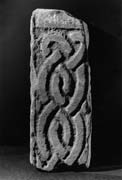Select a site alphabetically from the choices shown in the box below. Alternatively, browse sculptural examples using the Forward/Back buttons.
Chapters for this volume, along with copies of original in-text images, are available here.
Object type: Upper part of shaft [1]
Measurements: H. 59.5 (23.4 in) W. 32 cm (12.6 in) D. 21.4 cm (8.4 in)
Stone type: As North Otterington 1 (St Michael), except that the colour is brownish yellow (10YR 6/6).
Plate numbers in printed volume: Ills. 694–7
Corpus volume reference: Vol 6 p. 186
(There may be more views or larger images available for this item. Click on the thumbnail image to view.)
A (broad) : Very damaged at the top, with the edge mouldings lost. The top third is lost, then there is a transverse moulding below which is a lozenge-shaped filler, stretched horizontally, with a scooped centre. This lies above a pair of human figures, both cowled. The left-hand figure is wearing vestments which hang in a semicircular swag. The worn frontal face is framed by a pear-shaped hood. Within drapery folds is a rectangular element. The right-hand figure, damaged from below the shoulders, wears a cowl with a pointed hood. His right hand reaches to the other figure and holds either a key or a maniple.
B (narrow) : A possible chamfer hints at the neck of the cross. The modelled but damaged edge moulding, 1 inch wide, frames a long panel of dense interlace in modelled strand, cut free-hand. Some of its elements are almost stopped-plait. The terminals at the top belong to a standard four-cord plait, but the lower part of the pattern is idiosyncratic, with paired strands interlacing to form a central twist flanked by lying strands.
C (broad) : The edge moulding is modelled and within it at each side are vertical runs of two-cord twist, inclined inward at the top. In the central section a modelled strand passes down each side of the panel and at intervals turns across the face of the stone in three twists; five registers survive. Above this at the neck of the shaft is the remains of tightly packed interlace.
D (narrow) : The scraping of the surface has flattened the carving. The edge moulding is damaged and frames the top of the panel. The panel has a looser version of face B's four-cord plait, with central twists and lying strands.
The ladder-like twists of face C resemble those of Cotherstone 1 and Stanwick 1a–b (Ills. 119, 754, 758), though it remains an unusual device in the Riding. The modification of the closed circuits with internal twists is unique. Collingwood's identification of the figures as Christ's charging of St Peter is attractive in the light of the large key between them (Collingwood 1907, 379). The chief interest of the shaft lies in its iconography: it asserts the founding authority of the church, indicative of an ecclesiastical patron, yet the ornament has echoes of Anglo-Scandinavian taste. In this respect it is again like Stanwick 1 which has both Anglian and Anglo-Scandinavian traits. Evidently the church continued to commission sculpture with Anglian motifs well within the period of secular Viking patronage.



